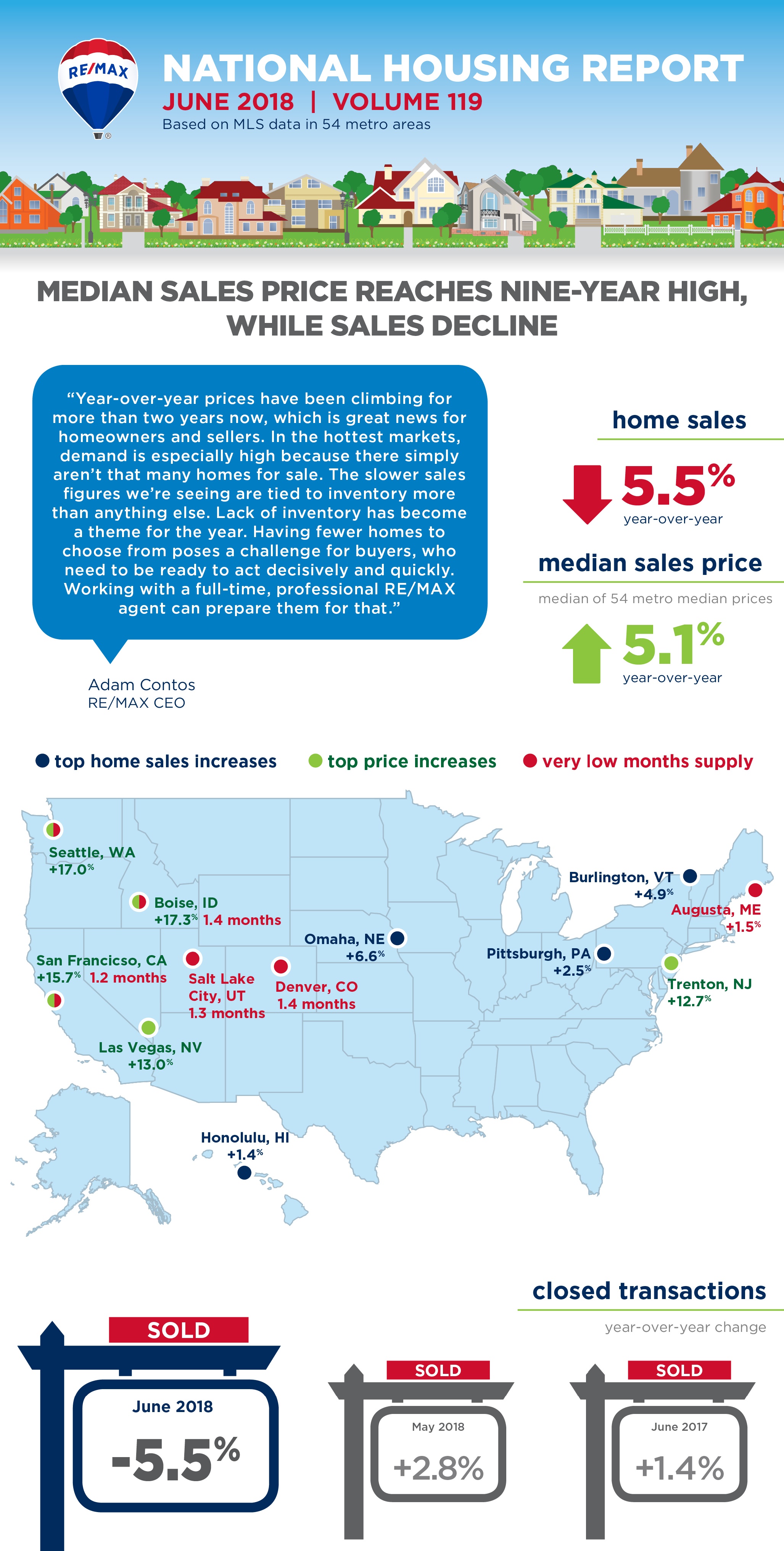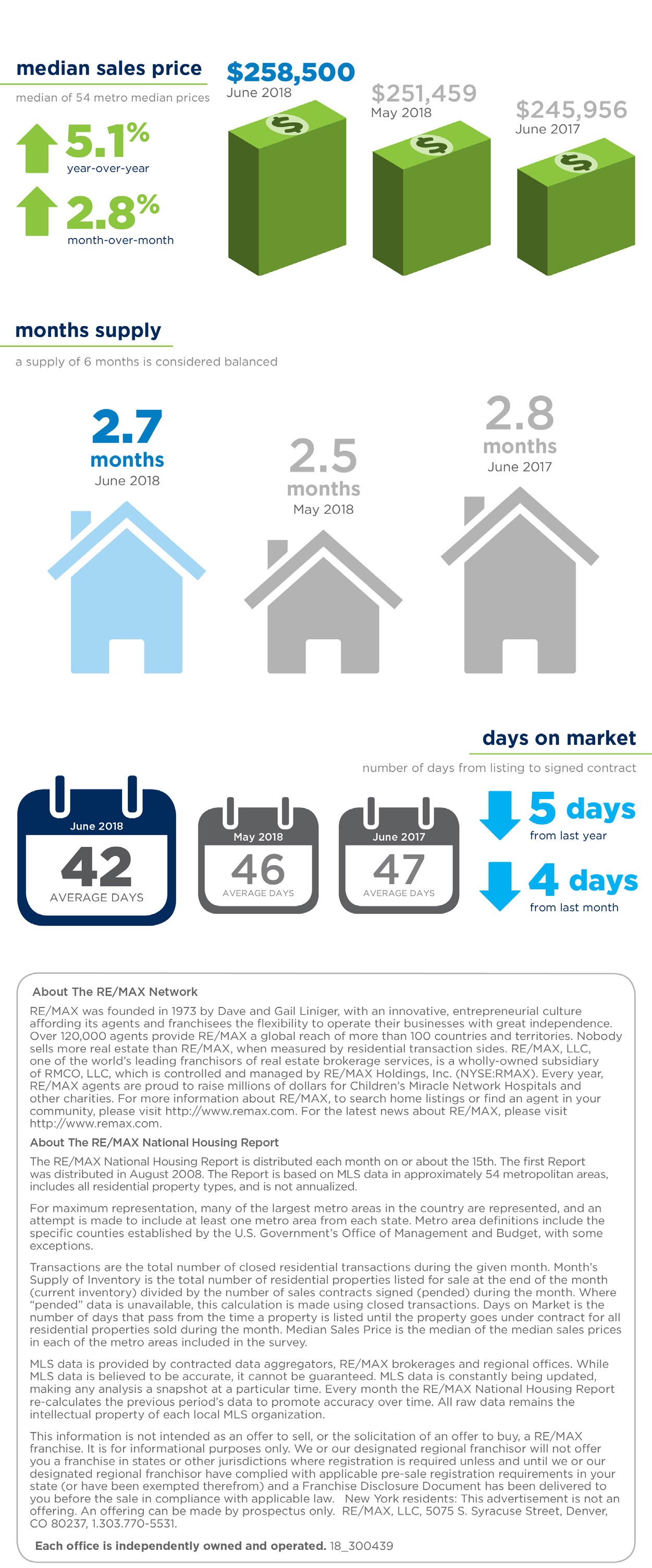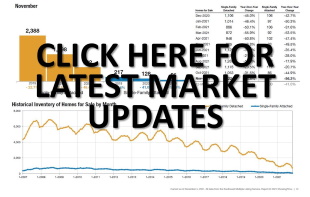RE/MAX National Housing Report for July 2019
Home Sales Increase 2.4% in July, Ending Nine Months of Inventory Growth
DENVER – July home sales bounced back after a sluggish June by increasing 2.4% year over year, according to the RE/MAX National Housing Report. This was enough to end nine months of year-over-year inventory growth as the number of homes for sale declined 1.4%.
A drop in home sales from June to July is typical in the report's 53 metro areas. But the 0.2% decline from June to July 2019 was by far the smallest month-over-month decline since July 2013. And while June sales failed to top May for only the second time in the report's 10-year history, July sales set a report record for the month.
"July sales snapped back after a tepid June, as attractive low interest rates appear to have brought more buyers into the mix," said RE/MAX CEO Adam Contos. "The housing market has been a bit uneven since the early spring, with each encouraging month seemingly followed by one with lukewarm results. It's possible the housing market has finally shaken some mud off its boots and can maintain its momentum for the back half of the year. If the broader macro environment hangs on, we could see a potentially strong finish to 2019."
July's Median Sales Price of $273,000 - while down slightly from June's all-time report record high - was 9.2% higher than July of 2018. It marked the seventh consecutive month of year-over-year price growth. Home prices have risen, year over year, in 88 of the last 90 months dating back to February 2012. Said Contos, "Although lower interest rates help affordability, we have now seen two straight months of accelerating price increases. If the trend continues, it's not an encouraging development for buyers."
July's Days on Market total of 43 saw sales closing at the same rate as they did in June, but taking two days longer than in July 2018. Months of Inventory in July 2019 totaled 2.7, down compared to June's 2.9 and 3.3 in July 2018.
Closed Transactions
Of the 53 metro areas surveyed in July 2019, the overall average number of home sales is down 0.2% compared toJune 2019, and up 2.4% compared to July 2018. Leading the month-over-month sales percentage increase wereHonolulu, HI at +11.8%, Anchorage, AK at +10.2%, and New York, NY at +9.2%.
Median Sales Price – Median of 53 metro median prices
In July 2019, the median of all 53 metro Median Sales Prices was $273,000, down 0.7% from June 2019, and up 9.2% from July 2018. Three metro areas saw a year-over-year decrease in Median Sales Price including Anchorage, AK at -3.2%, Trenton, NJ at -2.1%, and San Francisco, CA at -2.0%. Five metro areas increased year-over-year by double-digit percentages, with the largest increases seen in Wichita, KS at +16.7%, Cleveland, OH at +12.9%, and Cincinnati, OH at +11.7%.
Days on Market – Average of 53 metro areas
The average Days on Market for homes sold in July 2019 was 43, equivalent to the average in June 2019, and up two days from the July 2018 average. The metro areas with the lowest Days on Market were Omaha, NE at 21, Manchester, NH at 24, and Cincinnati, OH at 26. The highest Days on Market averages were in Augusta, ME at 87, Miami, FL at 82, and Hartford, CT at 72. Days on Market is the number of days between when a home is first listed in an MLS and a sales contract is signed.
Months Supply of Inventory – Average of 53 metro areas
The number of homes for sale in July 2019 was down 2.2% from June 2019 and down 1.4% from July 2018. Based on the rate of home sales in July 2019, the Months Supply of Inventory decreased to 2.7 compared to 2.9 in June 2019, and decreased compared to 3.3 in July 2018. A six months supply indicates a market balanced equally between buyers and sellers. In July 2019, of the 53 metro areas surveyed, only Miami, FL at 6.8 reported a months supply at or over six, which is typically considered a buyer's market. The markets with the lowest Months Supply of Inventory were Phoenix, AZ and Boise, ID, both at 1.5.
Feel free to contact me and I can help break down exactly what these numbers mean for our local market and for your neighborhood. And lastly, If you or anyone you know is thinking of buying or selling a home - please call or email me. I'm here to help!
Peter Veres
Associate Broker,CRS,ABR,CLHMS,SRES
Elite Asset Management Team - RE/MAX Elite
Cell: 505-362-2005














